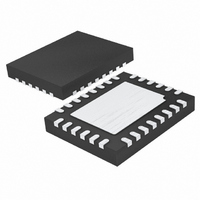LTC3850EUF#PBF Linear Technology, LTC3850EUF#PBF Datasheet - Page 12

LTC3850EUF#PBF
Manufacturer Part Number
LTC3850EUF#PBF
Description
IC CNTRLR STP DWN SYNC 28-QFN
Manufacturer
Linear Technology
Series
PolyPhase®r
Type
Step-Down (Buck)r
Datasheet
1.LTC3850EUFPBF.pdf
(38 pages)
Specifications of LTC3850EUF#PBF
Internal Switch(s)
No
Synchronous Rectifier
Yes
Number Of Outputs
2
Voltage - Output
0.8 ~ 23.3 V
Current - Output
100mA
Frequency - Switching
250kHz ~ 780kHz
Voltage - Input
4 ~ 24 V
Operating Temperature
-40°C ~ 85°C
Mounting Type
Surface Mount
Package / Case
28-QFN
Primary Input Voltage
24V
No. Of Outputs
2
Output Current
100mA
No. Of Pins
28
Operating Temperature Range
-40°C To +85°C
Msl
MSL 1 - Unlimited
Supply Voltage Range
4V To 24V
Rohs Compliant
Yes
Lead Free Status / RoHS Status
Lead free / RoHS Compliant
Power - Output
-
Available stocks
Company
Part Number
Manufacturer
Quantity
Price
LTC3850/LTC3850-1
OPERATION
When a controller is enabled for Burst Mode operation,
the peak current in the inductor is set to approximately
one-third of the maximum sense voltage even though
the voltage on the I
average inductor current is higher than the load current,
the error amplifier EA will decrease the voltage on the I
pin. When the I
sleep signal goes high (enabling “sleep” mode) and both
external MOSFETs are turned off.
In sleep mode, the load current is supplied by the output
capacitor. As the output voltage decreases, the EA’s output
begins to rise. When the output voltage drops enough, the
sleep signal goes low, and the controller resumes normal
operation by turning on the top external MOSFET on the
next cycle of the internal oscillator. When a controller is
enabled for Burst Mode operation, the inductor current is
not allowed to reverse. The reverse current comparator
(I
inductor current reaches zero, preventing it from revers-
ing and going negative. Thus, the controller operates in
discontinuous operation. In forced continuous operation,
the inductor current is allowed to reverse at light loads or
under large transient conditions. The peak inductor current
is determined by the voltage on the I
mal operation. In this mode, the efficiency at light loads is
lower than in Burst Mode operation. However, continuous
mode has the advantages of lower output ripple and less
interference with audio circuitry.
When the MODE/PLLIN pin is connected to INTV
the LTC3850 operates in PWM pulse-skipping mode at
light loads. At very light loads, the current comparator
I
external top MOSFET to stay off for the same number of
cycles (i.e., skipping pulses). The inductor current is not
allowed to reverse (discontinuous operation). This mode,
like forced continuous operation, exhibits low output ripple
as well as low audio noise and reduced RF interference
as compared to Burst Mode operation. It provides higher
low current efficiency than forced continuous mode, but
not nearly as high as Burst Mode operation.
12
CMP
REV
) turns off the bottom external MOSFET just before the
may remain tripped for several cycles and force the
TH
voltage drops below 0.5V, the internal
TH
pin indicates a lower value. If the
TH
pin, just as in nor-
CC
TH
,
Frequency Selection and Phase-Locked Loop
(FREQ/PLLFLTR and MODE/PLLIN Pins)
The selection of switching frequency is a trade-off between
efficiency and component size. Low frequency operation
increases efficiency by reducing MOSFET switching losses,
but requires larger inductance and/or capacitance to main-
tain low output ripple voltage. The switching frequency
of the LTC3850’s controllers can be selected using the
FREQ/PLLFLTR pin. If the MODE/PLLIN pin is not being
driven by an external clock source, the FREQ/PLLFLTR
pin can be used to program the controller’s operating
frequency from 250kHz to 780kHz.
A phase-locked loop (PLL) is available on the LTC3850
to synchronize the internal oscillator to an external clock
source that is connected to the MODE/PLLIN pin. The
controller is operating in forced continuous mode when
it is synchronized. A series R-C should be connected
between the FREQ/PLLFLTR pin and SGND to serve as
the PLL’s loop filter.
Power Good (PGOOD Pin)
The PGOOD pin is connected to an open drain of an internal
N-channel MOSFET. The MOSFET turns on and pulls the
PGOOD pin low when either V
±7.5% of the 0.8V reference voltage. The PGOOD pin is
also pulled low when either RUN pin is below 1.2V or when
the LTC3850 is in the soft-start or tracking phase. When
the V
MOSFET is turned off and the pin is allowed to be pulled
up by an external resistor to a source of up to 6V. The
PGOOD pin will flag power good immediately when both
V
an internal 17µs power bad mask when either V
out of the ±7.5% window.
Output Overvoltage Protection
An overvoltage comparator, OV, guards against transient
overshoots (> 7.5%) as well as other more serious con-
ditions that may overvoltage the output. In such cases,
the top MOSFET is turned off and the bottom MOSFET is
turned on until the overvoltage condition is cleared.
FB
pins are within the ±7.5% window. However, there is
FB
pin voltage is within the ±7.5% requirement, the
FB
pin voltage is not within
FB
goes
38501fc













